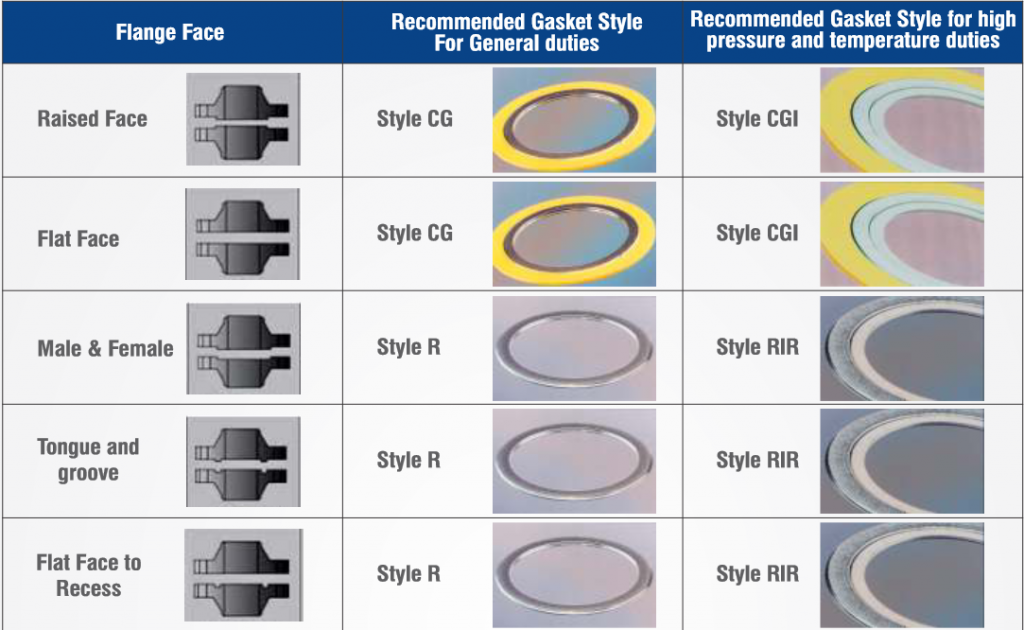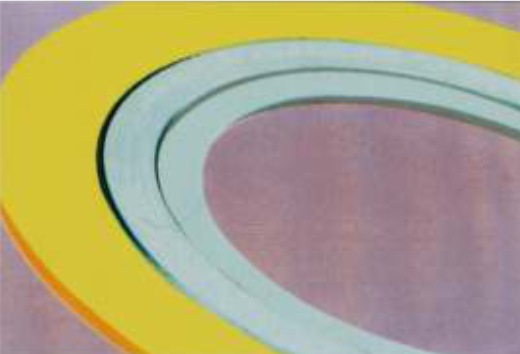
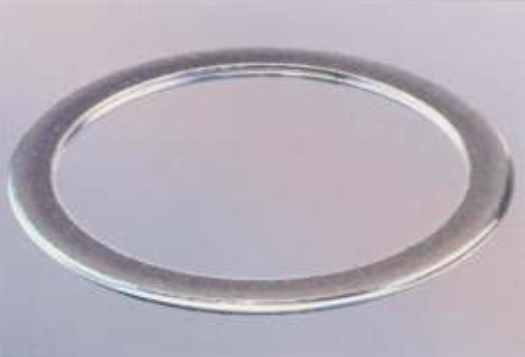
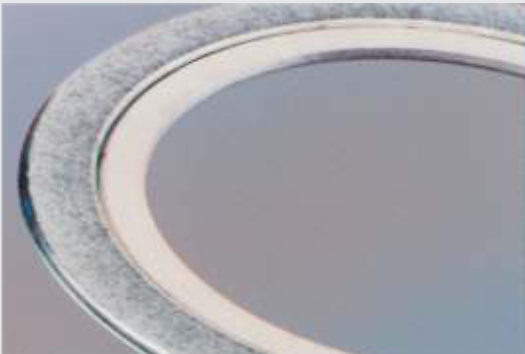
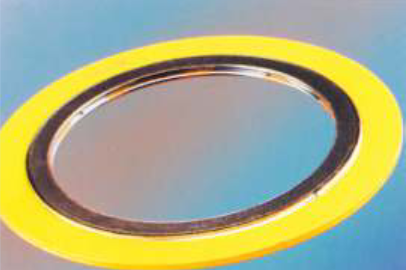
Spiral Wound Gaskets
The spiral wound gasket is semi-metallic, comprising of a spirally wound v-shaped stainless steel strip and a non-metallic filler material, such as graphite or PTFE.




Spiral Wound Gaskets
The spiral wound gasket is semi-metallic, comprising of a spirally wound v-shaped stainless steel strip and a non-metallic filler material, such as graphite or PTFE.
What is Spiral Wound Gasket?
Spiral wound gaskets are fabricated from thin metal strip sandwiched between layers of non-metallic filler.
SWG has alternative spiral layers of thin metal sheet and filler material as shown in the image. Here in the cross section, the blue layers are of metal, and the black layers are of filler material. As these layers are wounded in continues spiral forms, these types of gaskets are known as spiral wound gasket.

They can be used over the complete temperature range from cryogenic to approximately 1093ºC. This type of gasket can be used in all pressures from vacuum to the standard 2500 pressure class Range ratings.
Relatively low-density Spiral wound gaskets are used in vacuum service whereas extremely high-density Spiral wound gaskets are used in high-pressure service.The density of gasket is nothing but numbers of layers of filler and metal strip in the given width of the gasket.
What is Spiral Wound Gasket?
Spiral wound gaskets are fabricated from thin metal strip sandwiched between layers of non-metallic filler.
SWG has alternative spiral layers of thin metal sheet and filler material as shown in the image. Here in the cross section, the blue layers are of metal, and the black layers are of filler material. As these layers are wounded in continues spiral forms, these types of gaskets are known as spiral wound gasket.

They can be used over the complete temperature range from cryogenic to approximately 1093ºC.This type of gasket can be used in all pressures from vacuum to the standard 2500 pressure class Range ratings.
Relatively low-density Spiral wound gaskets are used in vacuum service whereas extremely high-density Spiral wound gaskets are used in high-pressure service.The density of gasket is nothing but numbers of layers of filler and metal strip in the given width of the gasket.
Components of Spiral Wound Gasket
There are three components in spiral wound gasket
- Outer Ring
- Winding Material (Filler & Metal Strip)
- Inner Ring
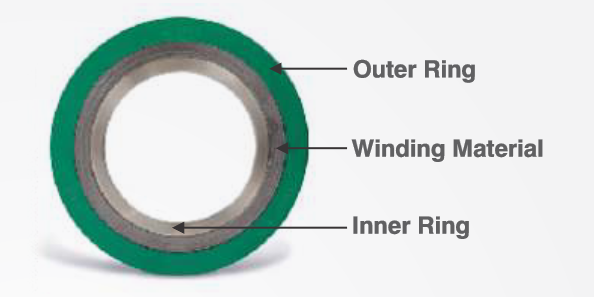
You can see in the image spiral wound gasket. As said, winding is an alternative layer of filler material and winding material. Winding can be a V-type or W-type. These V or W shape, under pressure it presses against the anges face and compresses the filling material to provide leak-proof joining.
The filler material can be graphite, PTFE, ceramic or other material depends on the service of the uid. Spot welding normally secures the inner and outer ends of the strip that wrap the filler material; the gasket is contained loosely in an outer backing ring
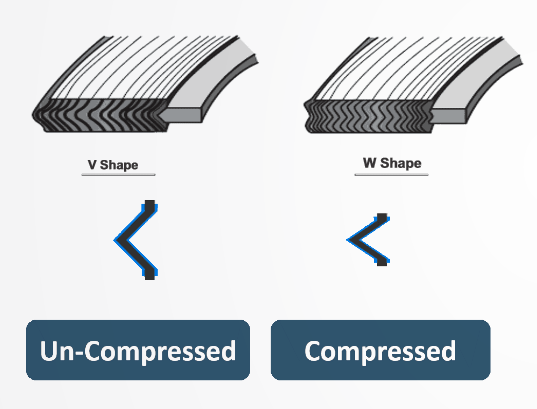
For applications involving raised face flanges, the spiral wound gasket is supplied with an outer ring made from Carbon steel, Stainless steel or other materials such as Monel or Nickel. The outer ring provides the centering capability of the gasket as well as the blow-out resistance of the windings and acts as a compression stop.
Many spiral wound gaskets for critical applications include an inner guide ring also, which gives the gasket a greater resistance to thermal shock and in the case of vacuum service prevent the filler material being sucked in. Inner rings should be used with spiral wound gaskets on male-and-female flanges, such as those found in heat-exchanger, shell, channel, and cover-flange joints.
Spiral wound ring gaskets are also used in tongue-and-groove flanges. When used in this type of flanges there will be no inner and outer metal rings as gasket are fit inside the groove.
Components of Spiral Wound Gasket
There are three components in spiral wound gasket
- Outer Ring
- Winding Material (Filler & Metal Strip)
- Inner Ring

You can see in the image spiral wound gasket. As said, winding is an alternative layer of filler material and winding material.Winding can be a V-type or W-type. These V or W shape, under pressure it presses against the anges face and compresses the filling material to provide leak-proof joining.
The filler material can be graphite, PTFE, ceramic or other material depends on the service of the uid. Spot welding normally secures the inner and outer ends of the strip that wrap the filler material; the gasket is contained loosely in an outer backing ring

For applications involving raised face flanges, the spiral wound gasket is supplied with an outer ring made from Carbon steel, Stainless steel or other materials such as Monel or Nickel. The outer ring provides the centering capability of the gasket as well as the blow-out resistance of the windings and acts as a compression stop.
Many spiral wound gaskets for critical applications include an inner guide ring also, which gives the gasket a greater resistance to thermal shock and in the case of vacuum service prevent the filler material being sucked in. Inner rings should be used with spiral wound gaskets on male-and-female flanges, such as those found in heat-exchanger, shell, channel, and cover-flange joints.
Spiral wound ring gaskets are also used in tongue-and-groove flanges. When used in this type of flanges there will be no inner and outer metal rings as gasket are fit inside the groove.
Types Of Spiral Wound Gaskets :
Style CG :
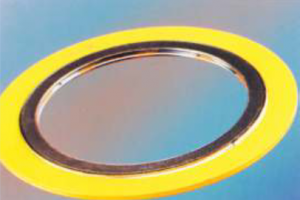
Utilizes an external ring which accurately centers gasket on flange face,provides additional radial strengths to prevent gasket blow-out and acts as a compression stop.
Style CGI :
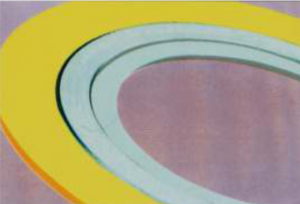
A style CG gasket fitted with internal ring which gives an additional compression limiting stop and provides heat and corrosion barrier protecting gasket windings and preventing gasket windings and preventing flange erosion .
Style R :

Basic construction type.Inner and outer diameters are
reinforced with several plies of metal without filler to give
greater stability and better compression and sealing
characteristics.
Style RIR :
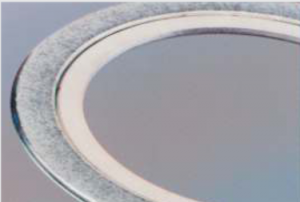
Solid inner metal ring acts as a compression stop and fills the annular space between range bore and the inside diameter of the gasket. Designed to prevent accumulation of solids,reduce turbulent low of process fluids and minimize erosion at flange faces.
Selection Of Spiral Wound Gaskets
